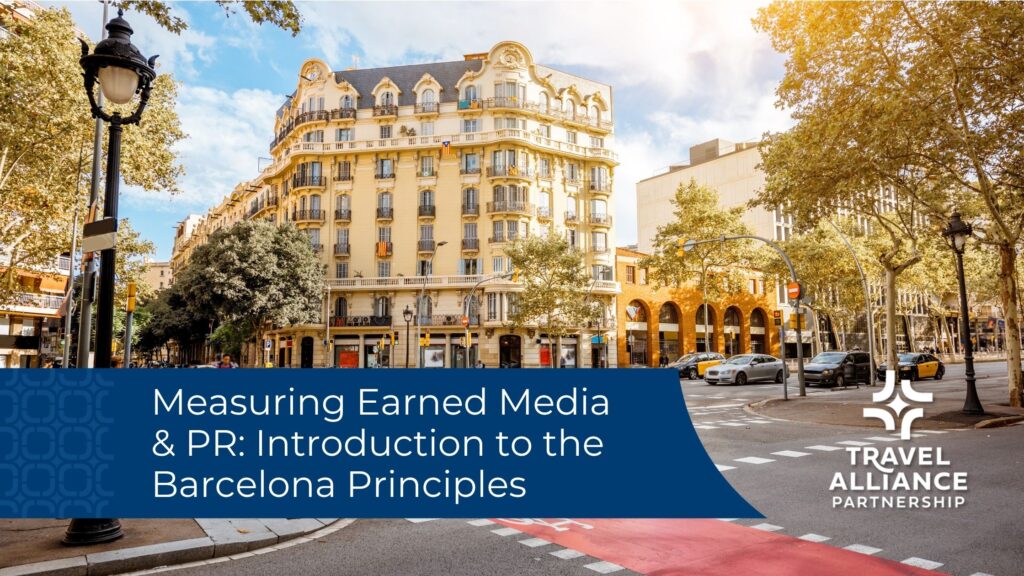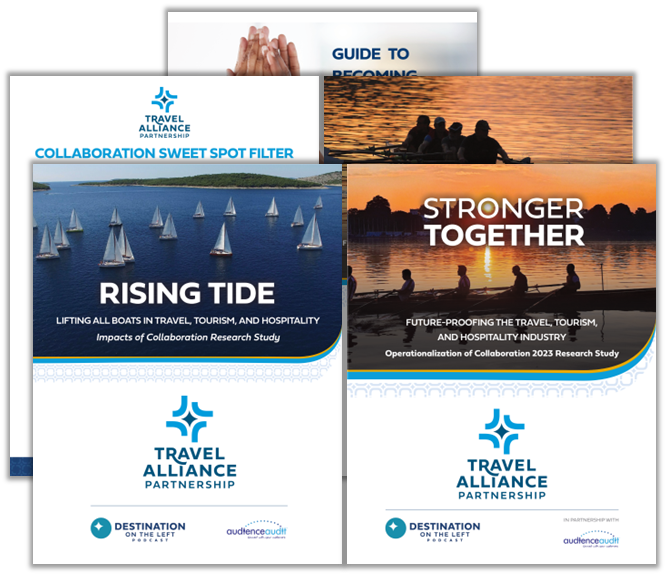Measuring Earned Media and PR: Introduction to the Barcelona Principles
Some may say a marketing campaign is only as good as the results it delivers. However, unlike digital content or paid advertising—where metrics are easily tracked—destination marketing professionals often face challenges when it comes to properly tracking, measuring, and analyzing public relations efforts and the resulting earned media placements.
Enter: The Barcelona Principles. Following this methodology, you can create a scoring system customized to your specific goals and campaign.

What Are the Barcelona Principles?
The Barcelona Principles are a set of seven principles that provide an overarching framework for effective public relations (PR) and communication measurement. This methodology is considered the industry standard for PR measurement.
Origin and Evolution of the Barcelona Principles
The Barcelona Principles were founded by the world’s largest media intelligence and insights professional body, International Association for Measurement and Evaluation of Communication (AMEC). They were adopted in 2010, when 200 PR professionals from 30 different countries convened in Barcelona at the Annual European Summit on Measurement.
As practices, methods and technology within the industry change, the Barcelona Principles evolve as well. Every five years they are reviewed and adjusted by a committee of PR professionals across the globe.
- 2010: Original version adopted
- 2015: Second version introduced
- 2020: Third version released
- 2025 (June): Fourth iteration published by AMEC
These principles aim not only to demonstrate proof of performance but also to demonstrate how to foster continuous improvement. Once you’re able to track and evaluate placements, you can adjust your efforts to gain more of the types of placements that you want.
A Brief History of PR Measurement
Before the Barcelona Principles
Prior to their introduction, communications professionals relied on different systems, such as Advertising Value Equivalency (AVE) or Ad Values, dating back to the 1940s.
This method compared the length of an earned placement to the size of advertising space, and calculated the cost of taking out an advertisement of the same size.
Example:
If an article was 10 column inches long in a paper charging $20 per inch, the AVE would be 10 x $20 = $200.
Sometimes this number was multiplied by 2x, 3x, or more – based on the assumption that earned media was more credible than advertising.
Limitations of AVE
The resulting metric would simply assign a dollar amount to an article – misrepresenting the true value of the earned media.
It did not take into account:
- Brand exclusivity in the piece
- Tone or sentiment
- Audience engagement
- Inclusion of key messages
Over time, additional metrics were used to measure outputs, such as the number of impressions or volume of media coverage. These data points indicated potential reach but didn’t provide insight on sentiment, effectiveness or the true impact of a placement.
And none of these easily translated to modern digital and social media platforms, which offer opportunities for additional audience engagement and tracking message adoption.
Eventually as PR professionals worked to solve the challenge of how to quantity their results, the Barcelona Principles were founded.
The Seven Barcelona Principles
These are the 7 basic beliefs that make up the Barcelona Principles 4.0:
1. Set Clear, Measurable Objectives
Setting clear, measurable objectives is a critical prerequisite for effective communication planning, measurement and evaluation.
Set all objectives before starting your campaign, and ensure they are SMARTER:
- Specific
- Measurable
- Achievable
- Relevant
- Time-bound
- Evaluated
- Reviewed
Rather than a “set it and forget it” approach, evaluating and reviewing your objectives allows for flexibility throughout the campaign. It also enables you to make adjustments based on lessons learned or audience response.
2. Understand All Stakeholder Audiences
Defining and understanding all stakeholder audiences are essential steps to plan, build relationships and create lasting impact.
As defined by PRSA, “Public relations is a strategic communication process that builds mutually beneficial relationships between organizations and their publics.” In order to build relationships with stakeholder audiences, we first need to understand who they are, what matters most to them and how to engage with them. In turn, this will improve campaign planning and gauging the outcomes and impact on your stakeholders.
For example, how will your campaign efforts impact your destination partners or community leaders?
3. Measure Across All Relevant Channels
Comprehensive communication measurement and evaluation should be applied to all relevant channels used to understand and influence audience stakeholders.
You should employ a comprehensive approach to understanding how your campaign and its messages are performing across all platforms.
This includes:
- Content created by influencers
- Conversations on social media platforms
- The impact of generative AI
Go beyond vanity metrics such as “likes” and “impressions” to focus on:
- Engagement
- Consideration
- Influencing behaviors
- Changing perceptions or attitudes
The data you track and analyze can help improve or course-correct a campaign.
4. Use Both Qualitative and Quantitative Analysis
Effective measurement and evaluation of communication requires qualitative and quantitative analysis.
On a similar note to principle 3, it is important to not just quantify but also understand how messages are being received, believed and interpreted.
Effective measurement requires combining both:
- Numerical data, which can report on the reach, share of voice and number of placements published
- Qualitative data, which helps explain “why” something worked, resonated or failed.
Together, you’re able to understand the motivations of your audiences and identify trends or patterns that can improve your communication strategies.
5. Do Not Use AVEs
Invalid measures such as advertising value equivalents (AVEs) should not be used. Instead, measure and evaluate the contribution of communication by its outcome and impact.
As explained earlier, AVEs do not paint the full picture of a PR result. A simple dollar value does not give you an idea of the quality or effectiveness of an article, whether it includes your key messages or if it is really reaching your goals. Creating a customized scoring system based off the Barcelona Principles will help you calculate a numerical value for every earned article or social media post associated with the campaign. That number will symbolize key factors that matter to the campaign – such as the inclusion of key messages or whether it is reaching your target stakeholders. It does not represent the “ROI” or cost of a placement.
6. Report on Outputs, Outcomes, and Impact
Measurement and Evaluation should report outputs, outcomes, and impact related to the organization and stakeholder audiences.
- Outputs are the immediate, tangible products of your communication efforts – such as a press release written about a new food trail or the number of media members invited to the launch event.
- Outcomes are the changes in awareness, attitude or behavior as a result of your communications efforts – like resulting media coverage in national publication or increased engagement on related social posts.
- Impact are the longer-term changes or effects, like the economic growth, brand reputation or shift in community sentiment.
Reviewing communication outputs, outcomes and impact together helps you understand the influence of efforts on your organization and the stakeholder audiences.
7. Uphold Ethics, Governance, and Transparency
Ethics, governance, and transparency with data, methodologies and technology builds trust and drives learning.
It is important to be transparent and ethical at all stages of monitoring, measuring and evaluating – including if, or how, artificial intelligence is used in the process. Be aware of regulations relating to how data is captured and used, and be mindful of any biases present in research that is used (such as the underrepresentation or misrepresentation of audiences in data sources) or while analyzing results
Applying the Barcelona Principles to Your Campaigns
Once you understand the Barcelona Principles and the purpose for using them to measure your PR campaigns, you are ready to set up your own customized scoring system.
Destinations International PR & Communications Task Force, of which TAP is a member, shared a Public Relations Measurement Guidelines Handbook for Destination Organizations that explains how to identify SMARTER objectives, set Key Performance Indicators (KPIs) and develop a scoring system for your organization.
On October 23rd 2025, we will host an interactive webinar to walk you through the consideration involved with creating a customized scoring system. Make sure you are subscribed to our newsletter to ensure you receive an invite when it’s time to register!
Related Posts
